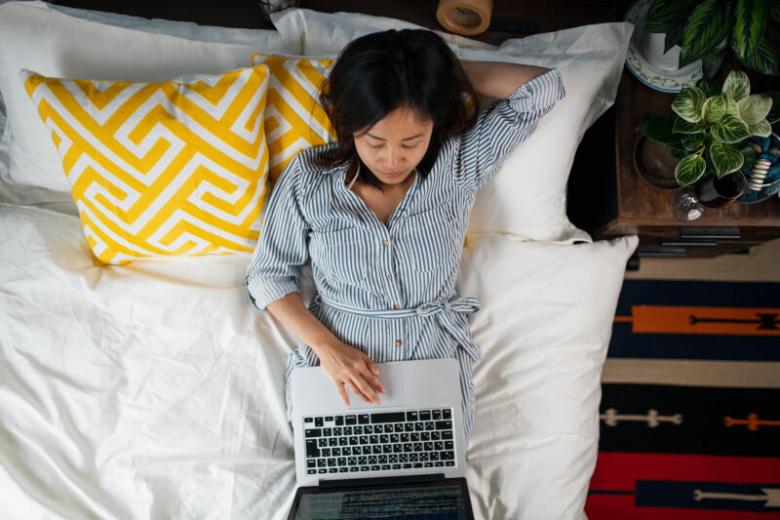SINGAPORE - Mrs Anna Tan bought an ergonomic chair last August so she could sit comfortably while working from home.
But her bed proved more appealing and she often found herself retreating there with her legs stretched out, laptop on her thighs and her head on the headboard.
The 36-year-old marketing executive, who has been working from home for the past year, like many people during the Covid-19 pandemic, would attend online meetings and write reports from the comfort of her bed.
Says Mrs Tan: "I switch up my workplaces. Sometimes I go to the cafe, sometimes I use the dining table at home, but most of the time, I choose to work from my bed, where it is most comfortable."
An administrative assistant, who wanted to be known only as Mr Koo, says he has found it "cosy and relaxing" to work from the bed.
"My family members use the common table in the living room and sometimes it can be distracting and not as conducive as it is in the bedroom," says the 33-year-old, who does not have a table in his room.
As comfortable as it may seem, working from the bed is not a good idea, experts tell The Straits Times.
Ergonomically speaking, it is the worst place to work from, be it to use your laptop, write letters or sign documents, says ear, nose and throat specialist Kenny Pang at Asia Sleep Centre.
"The neck and back would be curved in different ways just to get into a position to view the laptop or documents," he adds.
Ms Ho Yue Wan, a physiotherapist at Changi General Hospital (CGH), says it is difficult to maintain a good posture if one is working from the bed.
A good posture in a sitting position, she says, means relaxed shoulders with the eyes looking forward or slightly downwards. The back should be supported and leaning against a backrest with the feet touching the ground.
"An individual is unlikely to maintain such a posture when working from the bed," says Ms Ho.
While it may be comfortable to hit the sack for work, doing so for a long period can cause aches and pains.
For instance, Mr Koo has been experiencing neck and shoulder pain "possibly from the wrong posture and lack of proper back support", he says.
Mrs Tan feels her body becomes "a little stiff" when she works from the bed for long periods of time.
"When I put my laptop away and get up from the bed, I can feel the strain in my lower back and some ache in my wrists," she says.
However, she adds that the comfort she gets from working from the bed outweighs the aches she feels.
Dr Chua Soo Yong, an orthopaedic surgeon at Mount Elizabeth Hospital, says sitting in bed while working causes a flex posture of the lower back and neck due to increased pressure in the spinal discs, causing accelerated degeneration and putting the spine at risk of slipped discs.
Ms Ho and Dr Pang note that leaning against the headboard of the bed and placing the laptop on the thighs can cause a strain on one's neck when one keeps looking downwards at the screen.
Lying face down on one's stomach on the bed while working is also not a good idea.
Dr Chua says it could result in the spine going into hyper-extension. Prolonged hyper-extension of the lower back may result in abnormal muscular tension and spasms.
Lying in such a position also causes people to chronically flex their elbows, causing compression of the ulnar nerve, which then causes numbness of the hands, he adds.
People who work from the bed may also find it difficult to sleep at night.
Dr Tham Keng Seng, an associate consultant at CGH, says working from the bed could programme the brain to perceive it as a stressful environment, which can cause insomnia.
"It is a form of classical conditioning where the bedroom is paired with wakefulness, frustration and behaviour other than sleep, and when people are stressed and ruminate about work in the bedroom, they will have a harder time falling asleep," he says.
Agreeing, Ms Janet Chang, a senior clinical psychologist at CGH, says the bed is a cue for restful sleep for most people.
"Every time we lie down in bed, our mind and body are primed to enter a relaxed and sleepy state to get us ready for sleep, but working from the bed weakens this cue as it is an activity likely associated with wakefulness and stress," she says.
Operations executive intern Andrea Chua, who had trouble falling asleep at night, believes it could be due to her habit of working from the bed last year.
"I used to feel very alert when I got into bed at night. I think my mind was confused as to whether the bed was a place for work or sleep," says the 29-year-old, who now does her work on a table and has been taking melatonin gummies to help her fall asleep faster.
Melatonin is a hormone that is said to help regulate sleep-wake cycles.
For people who still prefer to work from the bed despite the aches, experts say they should get up and stretch regularly or use suitable furniture.
For example, Dr Pang suggests using ergonomic cushions, or a tray table or laptop stand to raise the height of the computer screen to relieve neck strain.
For Mr Koo, working from the bed is still the norm. While it causes aches and pain, it is also relaxing, he says. "It is a love-hate relationship, working from the bed."
Tips to make working in bed hurt less
1 Be in a seated position.
2 Ensure your laptop and/or work materials are placed at elbow height.
3 Prop up your workstation with firm support such as a laptop tray or a portable laptop desk.
4 Avoid hyper-flexion of the spine by arching forward, and avoid flexing the neck downwards.
5 If your legs are crossed most of the time, get up and move every 20 to 30 minutes to avoid numbness.
6 Avoid being in a fixed position for too long as it will result in abnormal muscle tension and can cause pain.
Source: Dr Chua Soo Yong, an orthopaedic surgeon at Mount Elizabeth Hospital
Get up and stretch
While there is no best posture for working from the bed, Ms Ho Yue Wan, a physiotherapist at Changi General Hospital, advises people to change the position they are in every 30 minutes to an hour.
She suggests: "Try to get up, walk a short distance and hydrate yourself with a cup of water before returning to work from the bed.
"Alternatively, you can perform some stretches during your break."
Stretching, when done often, can help to lower the risk of muscle aches and tension.
Ms Ho recommends doing these four stretching exercises.
Chest stretch

1. While standing or sitting, clasp both hands behind your back and gently bring your shoulder blades backwards.
2. Hold for 10 seconds.
3. Repeat three times on each side.
If you cannot clasp your hands together behind your back, hold onto a towel.
Neck stretch

1. You can do this while sitting or standing. Tilt your head sideways towards a shoulder.
2. Use your hand to pull gently to provide a gentle stretch.
3. Hold for 10 seconds.
4. Repeat three times on each side.
Try to look forward and avoid leaning your head forward or backward to get a good stretch.
Shoulder stretch

1. While standing or sitting, lift one arm above your head with your elbow bent.
2. Hold the elbow with the other hand and gently pull it towards the opposite side.
3. Tilt your body towards one side.
4. Hold for 10 seconds.
5. Repeat three times on each side.
If you have been working while seated or lying down, try to perform the first three exercises while standing to allow for a change of position.
Back exercise

1. Lie on your back with your knees bent.
2. Rock your knees to one side. Hold for 10 seconds.
3. Rock your knees to the opposite side. Hold for 10 seconds.
4. Repeat three times on each side.
Ensure your upper body is stationary. Try to move only your lower half.


